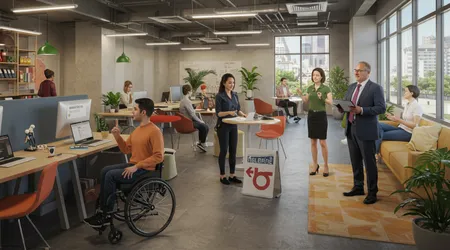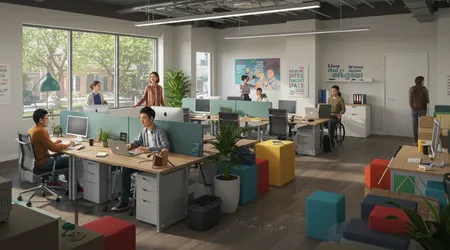How Accessible Are Modern Coworking Spaces, Really?

Modern coworking spaces have surged in popularity, promising flexible work environments for entrepreneurs, freelancers, and remote workers.
But how accessible are they truly? Accessibility in this context extends beyond physical infrastructure to include affordability, inclusivity, technological support, and geographic reach.
As the job market evolves and entrepreneurship thrives, these shared workspaces must cater to diverse needs.
This article explores whether modern coworking spaces deliver on their promise of universal access, dissecting physical, financial, and cultural barriers while offering practical insights for 2025’s workforce.
Coworking spaces emerged as a response to the gig economy’s rise, with 43% of U.S. workers expected to be freelancers by 2027, according to Statista.
They aim to bridge the gap between home offices and traditional workplaces. Yet, accessibility remains a complex issue.
Are these spaces truly inclusive, or do they cater primarily to a privileged few? This exploration dives into real-world challenges and solutions, grounded in current trends and authentic examples.
Physical Accessibility: Are Spaces Truly Universal?
Ramps, wide doorways, and braille signage are non-negotiable for physical accessibility in modern coworking spaces.
The Americans with Disabilities Act (ADA) mandates such features, yet compliance varies. Many spaces retrofit older buildings, where elevators or adjustable desks may be absent.
For instance, a wheelchair user in a converted warehouse coworking space in Brooklyn struggled with narrow hallways, highlighting inconsistent standards.
Beyond mobility, sensory accessibility matters. Quiet zones and adjustable lighting cater to neurodiverse individuals.
A coworking space in Seattle introduced soundproof pods after feedback from autistic members, enhancing focus.
Such adaptations are rare but critical. Without them, modern coworking spaces risk alienating those needing tailored environments.
++ The Rise of Disability-Owned Businesses: Trends and Insights
Physical access also includes geographic proximity. Urban hubs dominate, leaving rural entrepreneurs underserved.
A 2024 survey by Coworks found 68% of coworking spaces are city-based. Rural workers, like a freelance graphic designer in Montana, often lack local options, forcing reliance on home setups.
This urban bias limits the inclusivity of modern coworking spaces.

Financial Accessibility: Who Can Afford the Future of Work?
Cost is a formidable barrier in modern coworking spaces. Monthly memberships range from $100 to $500, per a 2024 Deskpass report.
High-end spaces in cities like San Francisco demand premium fees, excluding early-stage entrepreneurs. A startup founder in Austin shared how a $400/month membership strained her budget, forcing her to negotiate part-time access.
Flexible pricing models, like pay-per-use or subsidized memberships, are emerging solutions. A Chicago coworking space offers sliding-scale rates for low-income freelancers, boosting retention.
Yet, such initiatives are exceptions. Hidden fees printing costs or event surcharges further complicate affordability, especially for bootstrapped ventures.
Read more: Top 10 Low-Investment Business Ideas for Entrepreneurs with Disabilities
Subsidies or partnerships with local governments could ease burdens. For example, a Miami space partnered with a city program to offer free memberships to minority-owned startups.
This model fosters inclusivity but remains underutilized. Without broader adoption, modern coworking spaces may remain out of reach for many.
Technological Accessibility: Equipped for All?
High-speed internet and advanced tools define modern coworking spaces, but access to technology varies.
Urban spaces often boast 5G Wi-Fi and VR meeting rooms, yet rural or budget spaces lag with inconsistent connectivity.
A freelancer in a small-town Ohio coworking space reported frequent outages, disrupting client calls.
Software inclusivity is another hurdle. Not all members are tech-savvy. A coworking space in London introduced free digital literacy workshops, empowering older entrepreneurs to use collaboration tools.
Such initiatives bridge gaps but are not widespread. Without tech equity, modern coworking spaces fail to serve diverse skill levels.
Hardware access also matters. Spaces offering shared computers or 3D printers empower resource-strapped startups.
A Detroit space provides free access to design software, leveling the playing field for creatives.
Expanding such resources could ensure modern coworking spaces support all entrepreneurs effectively.
Cultural and Social Inclusivity: A Space for Everyone?
Inclusivity extends beyond ramps and routers it’s about belonging. Modern coworking spaces often market vibrant communities, but cultural barriers persist.
Women and minorities report feeling isolated in male-dominated or homogenous spaces. A 2024 Nexudus study noted 32% of female entrepreneurs felt unwelcome in certain coworking environments.
Events and networking can bridge gaps. A coworking space in Atlanta hosts diversity-focused workshops, fostering connections among underrepresented groups.
Yet, tokenism risks alienating members if events feel performative. Authentic inclusivity requires ongoing dialogue and representation in leadership.
Language barriers also challenge global entrepreneurs. A multilingual space in Miami offers signage and support in Spanish and Creole, easing access for non-English speakers.
Such efforts are vital as remote work globalizes. Without cultural sensitivity, modern coworking spaces cannot claim true accessibility.
The Rural-Urban Divide: A Geographic Challenge
The concentration of modern coworking spaces in urban areas creates a stark divide. Cities like New York and London boast hundreds of options, while rural areas struggle.
A 2025 Coworking Insights report found only 15% of spaces serve non-urban regions, limiting entrepreneurial ecosystems outside cities.
Mobile coworking units are an innovative fix. In rural Wales, a converted bus offers pop-up workspaces with Wi-Fi, serving remote workers weekly.
This model inspires but isn’t scalable without investment. Rural entrepreneurs, like a Vermont-based consultant, often rely on coffee shops, lacking professional amenities.
Partnerships with libraries or community centers could expand access. A pilot program in Nebraska transformed public libraries into coworking hubs, offering free Wi-Fi and meeting rooms.
Scaling such initiatives could democratize modern coworking spaces, bridging the geographic gap.

The Future of Accessibility in Coworking
Looking ahead, modern coworking spaces must innovate to be truly accessible. Technology like AI-driven design tools can optimize layouts for diverse needs.
Imagine a space where AI adjusts lighting or desk heights based on user profiles futuristic but feasible. Investment in rural infrastructure is equally critical to balance the urban bias.
Policy advocacy can drive change. Coworking operators could lobby for tax incentives to fund accessibility upgrades.
A San Francisco space secured grants for ADA compliance, setting a precedent. Collaboration with governments and nonprofits could amplify such efforts, ensuring inclusivity.
Community feedback is the linchpin. Spaces that actively solicit member input like a Toronto hub using monthly surveys adapt faster to diverse needs.
By prioritizing user voices, modern coworking spaces can evolve into truly inclusive hubs, reflecting the diverse job market of 2025.
Table: Accessibility Features in Coworking Spaces (2025 Trends)
| Feature | Urban Spaces | Rural Spaces |
|---|---|---|
| ADA-Compliant Infrastructure | 75% | 40% |
| High-Speed Internet | 90% | 55% |
| Flexible Pricing Models | 60% | 25% |
| Diversity-Focused Events | 50% | 15% |
| Source: Coworking Insights, 2025 |
Conclusion: A Work in Progress
Modern coworking spaces hold immense potential to empower entrepreneurs and remote workers, but accessibility remains a work in progress.
Physical, financial, technological, cultural, and geographic barriers persist, challenging the narrative of universal access.
Solutions like flexible pricing, tech training, and rural outreach show promise, but scaling them requires commitment.
Think of coworking spaces as a bridge to opportunity sturdy for some, shaky for others. Will the industry rise to meet diverse needs, or remain a privilege for the few?
By embracing innovation and inclusivity, modern coworking spaces can redefine the future of work.
FAQ: Common Questions About Coworking Accessibility
Q: Are coworking spaces ADA-compliant?
A: Many aim for compliance, but older buildings often lack full accessibility. Check specific spaces for ramps, elevators, and sensory accommodations.
Q: How can freelancers afford coworking memberships?
A: Look for spaces with pay-per-use options or sliding-scale rates. Some offer scholarships or partner with local programs for subsidies.
Q: Do rural areas have coworking spaces?
A: They’re limited, with only 15% of spaces in non-urban areas (Coworking Insights, 2025). Libraries or pop-up units may be alternatives.
Q: Are coworking spaces inclusive for non-English speakers?
A: Some offer multilingual support, but it’s not universal. Research spaces with language resources or community events for inclusivity.
Examples:
- Jane, a visually impaired freelancer, joined a Chicago coworking space with braille signage and screen-reader-compatible booking systems, boosting her productivity.
- Carlos, a startup founder in rural Idaho, accesses a mobile coworking van weekly, connecting with clients without relocating to a city.
Statistic: 43% of U.S. workers will be freelancers by 2027 (Statista, 2024).
Analogy: Coworking spaces are like public parks designed for all, but only truly accessible if paths, benches, and amenities cater to every visitor’s needs.
